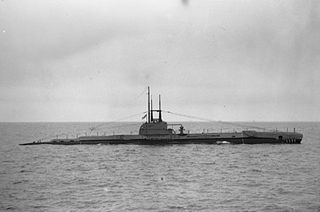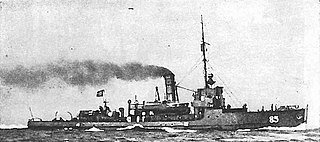
HMS Hesperus was an H-class destroyer that had originally been ordered by the Brazilian Navy with the name Juruena in the late 1930s, but was purchased by the Royal Navy after the beginning of World War II in September 1939, commissioned in 1940 as HMS Hearty and then quickly renamed as Hesperus.

Herbert Emil Schultze, was a German submarine commander during World War II. He commanded the U-48 for eight patrols during the early part of the war, sinking 169,709 gross register tons (GRT) of shipping. Schultze was a recipient of the Knight's Cross of the Iron Cross with Oak Leaves of Nazi Germany.

HMS Active, the tenth Active, launched in 1929, was an A-class destroyer. She served in the Second World War, taking part in the sinking of four submarines. She was broken up in 1947.

HMS Sturgeon was an S-class submarine that entered service with the Royal Navy in 1932. Ordered in 1930, she was laid down at Chatham Dockyard in January 1931 and launched on 8 January 1932. Commissioned on 27 February 1933, Sturgeon was assigned to the 2nd Submarine Flotilla.

HMS Seawolf was a second-batch S-class submarine built during the 1930s for the Royal Navy. Completed in 1936, the boat fought in the Second World War.

HMS Ursula was a U-class submarine, of the first group of that class constructed for the Royal Navy. The submarine entered service in 1938 and saw action during the Second World War in the North and Mediterranean Seas.

HMS Escapade was an E-class destroyer built for the Royal Navy in the early 1930s. Although assigned to the Home Fleet upon completion in 1934, the ship was attached to the Mediterranean Fleet in 1935–1936 during the Abyssinia Crisis. During the Spanish Civil War of 1936–1939 she spent considerable time in Spanish waters, enforcing the arms blockade imposed by Britain and France on both sides of the conflict. Escapade was assigned to convoy escort and anti-submarine patrol duties in the Western Approaches when World War II began in September 1939, but transferred back to the Home Fleet at the end of the year.

HMS Havelock was an H-class destroyer that had originally been ordered by the Brazilian Navy with the name Jutahy in the late 1930s, but was bought by the Royal Navy after the beginning of the Second World War in September 1939 and later renamed. She participated in the Norwegian Campaign in May 1940 and was assigned to convoy escort and anti-submarine patrols with the Western Approaches Command afterwards. The ship was briefly assigned to Force H in 1941, but her anti-aircraft armament was deemed too weak and she rejoined Western Approaches Command. Havelock became flotilla leader of Escort Group B-5 of the Mid-Ocean Escort Force in early 1942 and continued to escort convoys in the North Atlantic for the next two years. The ship was converted to an escort destroyer and sank one submarine during the war. After the end of the war, she escorted the ships carrying the Norwegian government in exile back to Norway and served as a target ship through mid-1946. Havelock was scrapped beginning in late 1946.

German submarine U-46 was a Type VIIB U-boat of Nazi Germany's Kriegsmarine during World War II. She had a highly successful career during the war.

The German destroyer Z4 Richard Beitzen was one of four Type 1934 destroyers built for the German Navy (Kriegsmarine) during the mid-1930s. Completed in 1937, the ship spent most of her time training although she did participate in the occupation of Memel in early 1939. At the beginning of World War II in September 1939, the ship was initially deployed to blockade the Polish coast, but was soon transferred to the Kattegat where she inspected neutral shipping for contraband goods. In late 1939 and early 1940, the ship laid two offensive minefields off the English coast that claimed 17 merchant ships. Z4 Richard Beitzen was in reserve during the Norwegian Campaign of early 1940 and was transferred to France later that year, where she made several attacks on British shipping.
Dundee International Submarine Memorial commemorates the 296 sailors and commandos lost on operations from the submarine base at Dundee in Scotland, HMS Ambrose, during World War II.
German submarine U-372 was a Type VIIC U-boat built for Nazi Germany's Kriegsmarine for service during World War II. She was laid down on 17 November 1939 by Kriegsmarinewerft Kiel as construction number 3, launched on 8 March 1941 and commissioned on 19 April 1941 under Kapitänleutnant Heinz-Joachim Neumann.

Albatros was the fourth of six Type 23 torpedo boats built for the German Navy. Completed in 1927, Albatros often served as a flagship of torpedo boat units. The ship made multiple non-intervention patrols during the Spanish Civil War in the late 1930s. After an attack by aircraft of the Spanish Republican Air Force killed German sailors in 1937, she participated in the retaliatory bombardment of Almería.

Falke was the sixth and last Type 23 torpedo boat built for the German Navy. The boat made multiple non-intervention patrols during the Spanish Civil War in the late 1930s. During World War II, she played a minor role in the Norwegian Campaign of 1940. Falke spent the next several months escorting minelayers as they laid minefields and damaged heavy ships back to Germany before she was transferred to France around September. She started laying minefields herself that month and continued to do so for the rest of the war. After a refit in early 1941, the boat was transferred to the Skaggerak where she was assigned escort duties. Falke returned to France in 1942 and was one of the escorts for the capital ships sailing from France to Germany through the English Channel in the Channel Dash. She helped to escort blockade runners, commerce raiders and submarines through the Channel and the Bay of Biscay for the next several years. The boat attacked Allied ships during the Invasion of Normandy in June 1944, but was sunk by British bombers that same month.

Möwe was the lead ship of her class of six torpedo boats built for the German Navy. The boat made multiple non-intervention patrols during the Spanish Civil War in the late 1930s. During the Norwegian Campaign of 1940, she played a minor in the attack on Oslo, the capital of Norway. Möwe was torpedoed and badly damaged by a British submarine in May and did not return to active service until 1942 when she was transferred to France. The boat helped to escort blockade runners, commerce raiders and submarines through the Bay of Biscay. She also laid numerous minefields and attacked Allied ships during the Invasion of Normandy in June 1944. Möwe was sunk by British bombers that same month.

Iltis was the lead ship of her class of six torpedo boats built for the German Navy during the 1920s. The boat made multiple non-intervention patrols during the Spanish Civil War in the late 1930s. During World War II, she did not participate in the Norwegian Campaign of 1940 as she was under repair after having accidentally rammed and sunk a U-boat. Iltis spent the next couple of years escorting minelayers as they laid minefields and laying minefields herself. She also spent the latter half of 1941 escorting convoys through the Skaggerak. The boat returned to France in 1942 and was one of the escorts for the capital ships sailing from France to Germany through the English Channel in the Channel Dash. Iltis then helped to escort one commerce raider through the Channel and was sunk by British forces while escorting another blockade runner in May.

Luchs was the fourth of six Type 24 torpedo boats built for the German Navy during the 1920s. The boat made multiple non-intervention patrols during the Spanish Civil War in the late 1930s. During World War II, she played a minor role in the Battle of Kristiansand during the Norwegian Campaign of 1940. Luchs was sunk in Norwegian waters in July by either a British submarine or a floating mine.

Jaguar was the sixth and last Type 24 torpedo boat built for the German Navy during the 1920s. The boat made multiple non-intervention patrols during the Spanish Civil War in the late 1930s. During World War II, she played a minor role in the Norwegian Campaign of 1940. Jaguar spent the next several months escorting minelayers as they laid minefields and damaged heavy ships back to Germany before she was transferred to France around September. She started laying minefields herself that month and continued to do so for the rest of the war. After a refit in early 1941, the boat was transferred to the Skaggerak where she was assigned escort duties. Jaguar returned to France in 1942 and was one of the escorts for the capital ships sailing from France to Germany through the English Channel in the Channel Dash. She helped to escort blockade runners, commerce raiders and submarines through the Channel and the Bay of Biscay, as well as Norwegian waters, for the next several years. The boat attacked Allied ships during the Invasion of Normandy in June 1944, but was sunk by British bombers that same month.

SMS M85 was a M1916 type minesweeper built for the Imperial German Navy during the First World War by the Emden shipyard Nordseewerke, being launched on 10 April 1918 and entering service on 2 October that year. M85 survived the remainder of the war, and was passed on to the Reichsmarine, the navy of the Weimar Republic and then to the Nazi German Kriegsmarine. The outbreak of the Second World War saw M85 supporting the German invasion of Poland in September 1939, and she was sunk by a Polish mine on 1 October 1939 in one of the last acts of the Polish campaign.
Sperrbrecher 18 was a Kriegsmarine sperrbrecher that was built in 1930 as the cargo ship Schürbek by Flensburger Schiffbau-Gesellschaft, Flensburg for Knöhr & Burchardt, Hamburg. She was requisitioned by the Kriegsmarine during World War II and was designated Schiff 40 and later Sperrbrecher 18. Severely damaged in an Allied air raid on Hamburg in March 1945, she was declared a constructive total loss and scrapped in 1948–49.
















